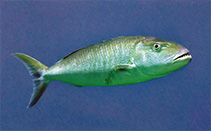| Family: |
Lutjanidae (Snappers), subfamily: Etelinae |
| Max. size: |
112 cm TL (male/unsexed); max.weight: 15 kg; max. reported age: 32 years |
| Environment: |
reef-associated; marine; depth range 0 - 180 m |
| Distribution: |
Indo-Pacific: East Africa to the Hawaiian Islands, north to southern Japan, south to Australia. |
| Diagnosis: |
Dorsal spines (total): 10-10; Dorsal soft rays (total): 11-11; Anal spines: 3-3; Anal soft rays: 8-8. This species is distinguished by the following characters: body elongate and robust; very distinct horizontal groove on snout ventral to nostrils; teeth in both jaws in bands, with strong canines anteriorly; teeth on roof of mouth in chevron- or crescent-shaped patch on vomer and in elongate band on each palatine; maxilla without scales or longitudinal ridges; interorbital region flattened; gill rakers on first gill arch 7-8 + 13-16 = 20-24; preopercular edge smooth, sometimes denticulated in juveniles; last soft ray of both dorsal and anal fins well produced, longer than next to last ray; caudal fin forked; short pectoral fins, less than 1/2 length of head, about equal to length of snout; D X,11 soft rays; membranes of dorsal and anal fins without scales; tubed lateral-line scales 48-50. Colour of body dark green, bluish, or grey-blue (Ref. 55, 9821). |
| Biology: |
Adults inhabit open waters of deep lagoons, channels, or seaward reefs (Ref. 9710). Found in benthopelagic waters (Ref. 58302). Usually seen singly, but also in groups. They feed mainly on fishes, but also on shrimps, crabs, cephalopods and planktonic organisms (Ref. 30573, 48635). Mainly marketed fresh but also dried and salted. Excellent eating. Large individuals may be ciguatoxic (Ref. 37816). |
| IUCN Red List Status: |
Least Concern (LC); Date assessed: 04 March 2015 Ref. (130435)
|
| Threat to humans: |
reports of ciguatera poisoning |
Source and more info: www.fishbase.org. For personal, classroom, and other internal use only. Not for publication.

